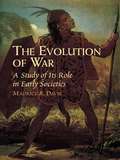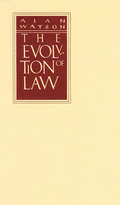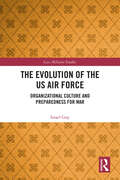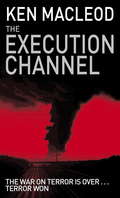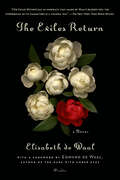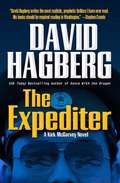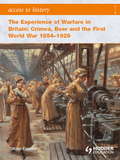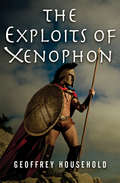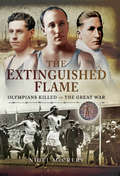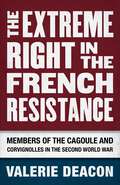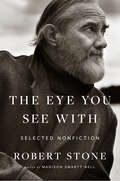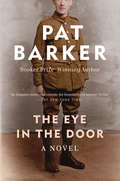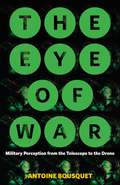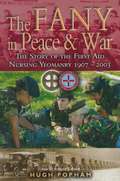- Table View
- List View
The Evolution of U.S. Military Policy from the Constitution to the Present, Volume II: The Formative Years for U.S. Military Policy, 1898-1940 (G - Reference,information And Interdisciplinary Subjects Ser.)
by Gian Gentile Sean M. Zeigler Alexandra Evans Badreddine AhtchiTracing the evolution of the U.S. Army throughout American history, the authors of this four-volume series show that there is no such thing as a “traditional” U.S. military policy. Rather, the laws that authorize, empower, and govern the U.S. armed forces emerged from long-standing debates and a series of legislative compromises between 1903 and 1940. Volume II focuses on the laws enacted in the early 20th century that transformed the Army.
The Evolution of U.S. Military Policy from the Constitution to the Present, Volume IV: The Total Force Policy Era, 1970–2015 (G - Reference,information And Interdisciplinary Subjects Ser.)
by Miranda Priebe Gian Gentile Jameson Karns Adam Givens Alexandra Evans M Wade MarkelTracing the evolution of the U.S. Army throughout American history, the authors of this four-volume series show that there is no such thing as a “traditional” U.S. military policy. Rather, the laws that authorize, empower, and govern the U.S. armed forces emerged from long-standing debates and a series of legislative compromises between 1903 and 1940. Volume IV traces how Total Force Policy has been implemented since 1970.
The Evolution of US Peacekeeping Policy Under Clinton: A Fairweather Friend?
by Michael G. MacKinnonThis fascinating study examines the dynamic process through which the Clinton administration developed a policy towards UN peace support operations. The author addresses the fundamental question: what factors influenced the shift in US policy towards the United Nations and its peace support operations and which factors were clearly dominant?Based on primary sources and interviews with political personalities and officials, the author examines four main factors which shaped the development of policy: the Executive branch, the bureaucracies (the State Department and Department of Defense), Congress and public opinion. These provide the basis for the core chapters of the book, which also contains a chapter on methodology and a chapter of summary analysis.
The Evolution of War: A Study of Its Role in Early Societies
by Maurice R. DavieThorough, highly informative and exhaustive study presents an exceptional collection of cases examining such topics as warfare as the business of one sex, religion as a cause of war, and war for the sake of glory. Cannibalism, human sacrifice, blood-revenge, and other factors in warfare among primitive peoples are also expertly examined.
The Evolution of Western Private Law
by Alan WatsonIn The Evolution of Western Private Law, renowned legal scholar Alan Watson presents a comprehensive overview of legal change in the Western world. Watson explains why and how such change occurs in mature systems, in underdeveloped systems, and when legal systems of different levels of sophistication and from different societal roots—such as those of the Romans and of Germanic tribes—come into contact.Originally intended as a second edition of the author's widely acclaimed The Evolution of Law (1985), this expanded edition has been completely restructured with more than double the number of examples. The result is a work that incorporates all the ideas that Watson has put forward during his twenty-five years studying comparative law and the development of legal systems, combining a remarkable range of sources with superb insight.
The Evolution of the US Air Force: Organizational Culture and Preparedness for War (Cass Military Studies)
by Israel GuyThis book looks at the history of the US Air Force through the lens of its (lack of) preparedness for major wars, which is shown to be a result of its organizational culture.The U.S. Air Force is probably the most powerful military force in history, both in its destructive firepower and in its ability to project it globally. Yet, despite its unparalleled power, the Air Force entered its first three pivotal conflicts – World War II, the Korean War, and the Vietnam War – unprepared. But surprisingly, it was remarkably well prepared for its fourth major war: the Gulf War of 1991. Could there be an underlying trait or characteristic, which influenced the Air Force between the wars, that historically caused the US Air Force to be unprepared for war or prepared for the wrong type of war? Surprisingly, there is such a factor which was quite prominent in the Air Force’s complex identity – its organizational culture. Besides providing a historical description of the Air Force, this book demonstrates clearly how its organizational culture evolved and how it caused the US Air Force to be prepared for the wrong war. It also shows that when the organizational culture changed, the Air Force changed its focus and arrived prepared for the following war: the 1991 Gulf War.This book will be of interest to students of air power, strategic studies, US public policy, and security studies in general.
The Excitements: A Novel
by CJ Wray"Irresistible...Filled with surprise, poignancy, and excitement, this is a surefire winner." --Publishers Weekly (starred review)A brilliant and witty drama about two brave female World War II veterans who survived the unthinkable without ever losing their killer instinct…or their joie de vivre.Meet the Williamson sisters, Britain’s most treasured World War II veterans. Now in their late nineties, Josephine and Penny are in huge demand, popping up at commemorative events and history festivals all over the country. Despite their age, they’re still in great form—perfectly put together, sprightly and sparky, and always in search of their next “excitement.”This time it’s a trip to Paris to receive the Légion d’honneur for their part in the liberation of France. And as always, they will be accompanied by their devoted great-nephew, Archie.Keen historian Archie has always been given to understand that his great aunts had relatively minor roles in the Women’s Royal Navy and the First Aid Nursing Yeomanry, but that’s only half the story. Both sisters are hiding far more than the usual “official secrets”. There’s a reason sweet Auntie Penny can dispatch a would-be mugger with an umbrella.This trip to Paris is not what it seems either. Scandal and crime have always quietly trailed the Williamson sisters, even in the decades after the war. Now armed with new information about an old adversary, these much decorated (but admittedly ancient) veterans variously intend to settle scores, avenge lost friends, and pull off one last, daring heist before the curtain finally comes down on their illustrious careers.
The Execution Channel: Novel
by Ken MacLeod'Distinctive, politically challenging, both tantalizing and satisfying.' - Kirkus Reviews'This man's going to be a major writer.' - Iain BanksFighting has spread across the Middle East and Central Asia to the borders of China. In the US, refugees from climate-change disaster subsist in FEMA camps. Images of official executions circulate on the Internet like al Qaeda videos. State agencies sponsor conspiracy theories as cover-ups. As the troops of the last superpower stand astride the last of the oil, China and Russia aren't the only states considering their options: certain nations of Old Europe are quietly preparing for the worst.James Travis is a middle-aged middle manager in a software company. He has a son in the army, a daughter in a peace-protest camp outside a USAF base, and a compromising relationship with a foreign intelligence service. When his cover is blown hours before a nuclear explosion destroys the base, Travis, his son, and his daughter are all in serious trouble. And as the spooks and disinformation specialists focus their efforts on his capture, Travis knows that all it will take is one mistake and his only memorial will be another grainy video on . . . The Execution Channel.Ken MacLeod's most relevant and accessible novel to date.Books by Ken MacLeod:Fall RevolutionThe Star FractionThe Stone CanalThe Cassini DivisionThe Sky RoadEngines of LightCosmonaut KeepDark LightEngine CityCorporation Wars TrilogyDissidenceInsurgenceEmergenceNovelsThe Human FrontNewton's WakeLearning the WorldThe Execution ChannelThe Restoration GameIntrusionDescent
The Exeter Blitz
by David ReesIt was the night of May 3-4, 1942, and the Lockwoods were scattered all over Exeter. Colin's mother was at the dress shop where she worked. Mary and her boyfriend Lars were at the cinema. June and Mr. Lockwood were at home. And Colin was in the tower of the city's historic cathedral. Wherever they were, they could hear the sirens start, and they knew what that meant... But this air raid was like no bombing before. Bombs fell like rain, bursting apart houses and shops and streets, followed by incendiary shells. Soon the city was engulfed by a fire storm, and the low-flying planes machine-gunned rescue workers and everyone else. Only the ancient medieval cathedral went relatively unscathed. As morning dawned, bringing the all-clear, the Lock woods emerged, each from the place where he had taken shelter, and looked about, checking to see who had survived. Their house was in ruins, their lives had been changed, but as each face reappeared, they knew that they had much to be thankful for. David Rees here re-creates the feelings and experiences of a family living through a war.
The Exile: The American; The Assassin; The Invisible; The Exile (A Ryan Kealey Thriller #4)
by Andrew BrittonFor the President of the United States, the daily horror of life in West Darfur's killing fields just hit heartbreakingly close to home. His niece, Lily, has been targeted and savagely murdered by a corps of fearsome government-backed militiamen. With the situation too explosive for diplomatic or military solutions, yet with the President and the public thirsting for revenge, America is out of options. Except one: Ryan Kealey, ex-Special Forces, former CIA, and unrivaled counterterrorism expert.Kealey has been central to the war on terror for over a decade. But after the Agency hung him out to dry--and let his lover die--he turned his back. Until now. For the government has revealed its trump card, the one thing Kealey will risk everything for. Soon, from the lawless streets of Sudan to the highest levels of the American government, Kealey unearths secrets and betrayals that shock even his war-tempered sensibilities--and ignite a conflagration with unknowable global consequences. "In this age of terrorism, [Britton's] plots seem to jump straight out of the headlines. . .he may well give Tom Clancy a run for the money." –St. Louis Post-Dispatch on The Invisible"The Assassin is the 'best' of Tom Clancy, Michael Connelly, and Robert Ludlum all rolled into a single book." --armchairinterviews.com "Brilliantly well-written with plotting sharper than a fence full of razor wire, a sizzling page-turner." --Brad Thor, New York Times bestselling author on The American
The Exiles Return: A Novel
by Elisabeth de WaalWITH A FOREWORD BY EDMUND DE WAAL, AUTHOR OF THE HARE WITH AMBER EYESSET IN THE ASHES OF POST–SECOND WORLD WAR VIENNA, A POWERFUL, SUBTLE NOVEL OF EXILES RETURNING HOME FIFTEEN YEARS AFTER FLEEING HITLER'S DEADLY REIGN Vienna is demolished by war, the city an alien landscape of ruined castles, a fractured ruling class, and people picking up the pieces. Elisabeth de Waal's mesmerizing The Exiles Return is a stunningly vivid postwar story of Austria's fallen aristocrats, unrepentant Nazis, and a culture degraded by violence.The novel follows a number of exiles, each returning under very different circumstances, who must come to terms with a city in painful recovery. There is Kuno Adler, a Jewish research scientist, who is tired of his unfulfilling existence in America; Theophil Kanakis, a wealthy Greek businessman, seeking to plunder some of the spoils of war; Marie-Theres, a brooding teenager, sent by her parents in hopes that the change of scene will shake her out of her funk; and Prince "Bimbo" Grein, a handsome young man with a title divested of all its social currency.With immaculate precision and sensitivity, de Waal, an exile herself, captures a city rebuilding and relearning its identity, and the people who have to do the same. Mesmerizing and tragic, de Waal has written a masterpiece of European literature, an artifact revealing a moment in our history, clear as a snapshot, but timeless as well.
The Expediter (Kirk McGarvey Series #13)
by David HagbergLate one balmy summer evening in Pyongyang, an important Chinese intelligence general on his way to a secret meeting with Kim Jon-Il is assassinated in plain sight of a surveillance camera. The two shooters are wearing the uniforms of North Korean police officers. Kim Jong-Il denies any knowledge of the shooting, but the Chinese do not believe him. As they prepare to attack, Jong-Il promises to unleash his nuclear weapons on downtown Beijing, Seoul, and Tokyo, plunging the entire region into nuclear war. Kirk McGarvey, just off a difficult assignment that took him to Mexico City, has returned to his visiting professorship at the University of South Florida. A colonel in North Korea's intelligence service shows up in person, asking McGarvey to prove that North Korea did not authorize the hit. It's the most extraordinary request McGarvey has ever received. He enters a dangerous international shadow world where almost nothing is as it seems. The puzzles lead him to a mysterious Russian ex-KGB multimillionaire whose specialty is expediting assassins for hire, to Pyongyang where he finds the wedge to open up a far-reaching plot so monstrous the entire world could go up into flames, and finally back to the one nation that potentially has the most to gain by such a war. And the most to lose . . .
The Experience of Warfare in Britain: Crimea, Boer and the First World War 1854-1929 (Access to History)
by Alan FarmerAbout the series: The Access to History series is the most popular and trusted series for advanced level history students, offering: <P><P>Authoritative, engaging and accessible content <Br>Comprehensive coverage of the AS and A level history specifications<BR>Design features, study guides and web support to help students achieve exam success.<P>About the book: <P>This title covers the experience of warfare in Britain and the social and political effects that had in the late nineteenth and early twentieth centuries. It examines major questions such as:<P>What was the impact of the Crimean War?<BR>What was the impact of the Second Boer War?<BR>What was the experience of war on the Western Front?<BR>What was the impact of the First World War on the Home Front?<P>Throughout the book, key dates, terms and issues are highlighted, and historical interpretations of key debates are outlined. Summary diagrams are included to consolidate knowledge and understanding of the period, and exam-style questions and tips written by a senior examiner provide the opportunity to develop exam skills.
The Experimental Units of Hitler's Condor Legion: German Aircraft In Action During the Spanish Civil War (Air War Archive)
by Rafael A. Permuy LópezAt the start of the Spanish Civil War the nationalists sought help for their cause from Germany, following which volunteers from the German Air Force and Army formed what was called the Condor Legion. This force made a significant contribution to General Francos eventual victory and this included two experimental air units, known as VJ/88 and VB/88. The formers mission was to combat test the new monoplane fighters; the Messerschmitt Bf 109 and the Heinkel He 112. The latter groups task was to test the new twin-engine, retractable undercarriage bombers; the Heinkel He 111, the fast Dornier Do 17 and the Junkers Ju 86.The Heinkels made their combat debut on 9 March 1937, when they attacked Republican held airfields in support of the Battle of Guadalajara. The Heinkel proved superior to the two other German medium bombers, being both faster and carrying a heavier bomb load. Likewise, the Messerschmitt Bf 109 was quickly found to be the better of the two fighters. This book aims to examine the history of the men and machines that served in those units. The Fhrer thought the matter over. I urged him to give support [to Franco] under all circumstances, firstly, in order to prevent the further spread of communism in that theatre and, secondly, to test my young Luftwaffe at this opportunity in this or that technical respect.Herman Gring at the Nuremberg War Trials.
The Exploits of Xenophon
by Geoffrey HouseholdThousands of miles from home, one soldier leads an army to safety The war with Sparta is over, and Athens is at peace for the first time in thirty years. Their Greek enemies subdued, the generals of Athens turn their eyes to the East, where the Persian Empire stretches to the edge of the known world. Never before have Greek soldiers marched into Persia. Xenophon will be among the first. A warrior whose bravery is matched only by his intelligence, Xenophon is a natural leader. When his army of ten thousand men is stranded far from home, it is up to him to lead them back to Greece without sacrificing the principles of democracy that they hold so dear. A retelling of Xenophon's classic Anabasis, this is a thrilling tale of bravery and survival, in which the mind is as valuable a weapon as the sword.
The Extinguished Flame: Olympians Killed in The Great War
by Nigel McCreryIn August 2016 the world will be spellbound by the Olympic Games in Rio de Janeiro as 10,500 athletes from 206 countries compete in 306 events. Tracing their origins back to the Greeks in 776 BC, the history of the Olympics is a glorious one but it has had its darker moments.During the First World War no fewer than 135 Olympians perished. Many had won Gold, Silver and Bronze medals. They came not just from the UK, Germany, France, USA but from all over the globe.Wyndham Halswelle, killed in action on 31 March 1915, won a Gold, Silver and Bronze medals in both field and track events. The Frenchman Leon Flameng, the fastest cyclist ever, died on 2 January 1917, having won Gold, Silver and Bronze medals in the 1896 Olympics. The German Fritz Bartholomae, killed in action 12 September 1915, won a Bronze in the rowing eights during the 1912 Olympics. The list of these heroes goes on and on. Each Olympian, who made the supreme sacrifice, is honoured in this magnificent book by a summary of their life, sporting achievement and manner of their death.
The Extreme Right in the French Resistance: Members of the Cagoule and Corvignolles in the Second World War
by Valerie DeaconIn the aftermath of World War II, historical accounts and public commentaries enshrined the French Resistance as an apolitical, unified movement committed to upholding human rights, equality, and republican values during the dark period of German occupation. Valerie Deacon complicates that conventional view by uncovering extreme-right participants in the Resistance, specifically those who engaged in conspiratorial, anti-republican, and quasi-fascist activities in the 1930s, but later devoted themselves to freeing the country from Nazi control. The political campaigns of the 1930s—against communism, republicanism, freemasonry, and the government—taught France’s ultra-right-wing groups to organize underground movements. When France fell to the Germans in 1940, many activists unabashedly cited previous participation in groups of the extreme right as their motive for joining the Resistance. Deacon’s analysis of extreme-right participation in the Resistance supports the view that the domestic situation in Nazi-controlled France was more complex than had previously been suggested. Extending beyond past narratives, Deacon details how rightist resisters navigated between different options in the changing political context. In the process, she refutes the established view of the Resistance as apolitical, united, and Gaullist. The Extreme Right in the French Resistance highlights the complexities of the French Resistance, what it meant to be a resister, and how the experiences of the extreme right proved incompatible with the postwar resistance narrative.
The Eye You See With: Selected Nonfiction
by Robert StoneThe definitive collection of nonfiction—from war reporting to literary criticism to the sharpest political writing—from the &“legend of American letters&” (Vanity Fair) Robert Stone was a singular American writer, a visionary whose award-winning novels—including Dog Soldiers, Outerbridge Reach, and Damascus Gate—earned him comparisons to literary lions ranging from Samuel Beckett to Ernest Hemingway to Graham Greene. Stone had an almost prophetic grasp of the spirit of his age, which he captured with crystalline clarity in each of his novels. Of course, he was also a sharp and brilliant observer of American life, and his nonfiction writing is revelatory. The Eye You See With—the first and only collection of Robert Stone&’s nonfiction—was carefully selected by award-winning novelist and Stone biographer Madison Smartt Bell. Divided into three sections, the collection includes the best of Stone&’s war reporting, his writing on social change, and his reflections on the art of fiction. This is an extraordinary volume that offers up a clear-eyed look at the 20th century and secures Robert Stone&’s place as one of the most original figures in all of American letters.
The Eye in the Door: The Second Volume Of The Regeneration Trilogy (The Regeneration Trilogy #2)
by Pat BarkerIt is the spring of 1918, and Britain is faced with the possibility of defeat by Germany. A beleaguered government and a vengeful public target two groups as scapegoats: pacifists and homosexuals. Many are jailed, others lead dangerous double lives, the "the eye in the door" becomes a symbol of the paranoia that threatens to destroy the very fabric of British society. <p><p> Central to this novel are such compelling, richly imagined characters as the brilliant and compassionate Dr. William Rivers; his most famous patient, the poet Siegfried Sassoon; and Lieutenant Billy Prior, who plays a central role as a domestic intelligence agent. With compelling, realistic dialogue and a keen eye for the social issues that have gone overlooked in mainstream media, The Eye in the Door is a triumph that equals Regeneration and the third novel in the trilogy, the 1995 Booker Prize-winning The Ghost Road, establishing Pat Barker's place in the very forefront of contemporary novelists.
The Eye of War: Military Perception from the Telescope to the Drone
by Antoine BousquetHow perceptual technologies have shaped the history of war from the Renaissance to the present From ubiquitous surveillance to drone strikes that put &“warheads onto foreheads,&” we live in a world of globalized, individualized targeting. The perils are great. In The Eye of War, Antoine Bousquet provides both a sweeping historical overview of military perception technologies and a disquieting lens on a world that is, increasingly, one in which anything or anyone that can be perceived can be destroyed—in which to see is to destroy. Arguing that modern-day global targeting is dissolving the conventionally bounded spaces of armed conflict, Bousquet shows that over several centuries, a logistical order of militarized perception has come into ascendancy, bringing perception and annihilation into ever-closer alignment. The efforts deployed to evade this deadly visibility have correspondingly intensified, yielding practices of radical concealment that presage a wholesale disappearance of the customary space of the battlefield. Beginning with the Renaissance&’s fateful discovery of linear perspective, The Eye of War discloses the entanglement of the sciences and techniques of perception, representation, and localization in the modern era amid the perpetual quest for military superiority. In a survey that ranges from the telescope, aerial photograph, and gridded map to radar, digital imaging, and the geographic information system, Bousquet shows how successive technological systems have profoundly shaped the history of warfare and the experience of soldiering. A work of grand historical sweep and remarkable analytical power, The Eye of War explores the implications of militarized perception for the character of war in the twenty-first century and the place of human subjects within its increasingly technical armature.
The Eye of Winter's Fury: Destiny Quest Book 3 (DESTINYQUEST)
by Michael J. WardThe cold north awaits you ... War is coming to Valeron. From the west, the blood-thirsty Wiccans burn and pillage their way towards the capital - where an ill and ineffectual king is beset on all sides by the scheming of ambitious men. His youngest son, Prince Arran, untested in combat and naïve to ways of the world, is sent on a fool's errand - to convince a cowardly lord to honour his oath and defend the realm from its enemies. But the real threat is yet to be revealed ...You are Prince Arran, son of Leonidas and second heir to the throne of Valeron. They call you the ghost prince - the sickly boy who haunts the palace library, filling your head with dreams of high adventure. Now, as the shadows lengthen and danger threatens your beleaguered kingdom, you must finally prove yourself. It is time to take up your hallowed sword, Duran's Heart, and forge your own destiny in a cruel and savage world - one that has no mercy for weakling princes. No happy endings. Will you defy fate and become a great hero of legend? You decide in this epic fantasy adventure - one where you make the decisions. The cold north awaits you ... are you ready for the challenge?
The Eyes of the Beholders: The Eyes of the Beholders (Star Trek: The Next Generation #13)
by A.C. CrispinThe U.S.S. Enterprise is sent on a mission to find missing Klingon ships, but what they find threatens the lives of all those aboard the ship. After several Federation and Klingon ships disappear while traveling a newly opened trade route, the U.S.S. Enterprise is sent to investigate. Their quest leads Captain Picard and his crew to an eerie space graveyard full of ships of every size and description, all of them, dead in space. At the center of the graveyard lies a huge, incredibly powerful artifact, constructed by an ancient alien race. And as the crew struggles to solve the mystery of the artifact, they unwittingly trigger its awesome power, a power that threatens insanity and death to all aboard the Starship Enterprise.
The FANY in Peace & War: The Story of the First Aid Nursing Yeomanry 1907–2003
by Hugh PophamThe strangely named First Aid Nursing Yeomanry traces its origins to the Great War. As a mark of their outstanding service they remained in being between the wars. However, it is for their service during the Second World War that they are best known. They worked in a wide variety of roles both at home and overseas, both overt and covert and today are still making a vital contribution.
The FN FAL Battle Rifle
by Steve Noon Robert CashnerOf all the infantry small arms developed during World War II, one that generated the most interest was the German 'assault rifle', the StG 44 Sturmgewehr. This innovative weapon fired an intermediate cartridge much more powerful and long-ranged than the standard pistol rounds used in submachine guns, but smaller and lighter than a full-size 7.92mm rifle round, producing less recoil and enabling the soldier to carry more ammunition. The StG 44 and the Soviet weapon it inspired, the AK-47 in 7.62x39mm calibre, could still effectively and accurately engage targets on semi-automatic out to 300m, but when close-range firepower was needed could fire on full-automatic like a submachine gun.In the West, the NATO countries looked hard at new weapons to upgrade their own infantry arsenals and counter the AK-47. Although British and other designers developed their own prototype assault rifles chambered for intermediate cartridges, the Americans adopted the M14 'battle rifle' and forced a common full-length calibre, 7.62x51mm, on their NATO allies. Fabrique Nationale of Belgium designed a new military rifle, the Fusil Automatique Léger or FAL, as an assault rifle using a true intermediate cartirdge, but this innovative weapon also proved to be a successful battle rifle when adapted for the full-length NATO round. It was soon adopted by the military and police forces of no fewer than 93 nations around the globe, from the United Kingdom to Israel, and was manufactured under licence on every populated continent. It remains in production to this day and is regarded by most as the quintessential postwar battle rifle. In fact, the FAL dominated the militaries of the West to such a degree that its nickname became the Right Arm of the Free World. Roughly comparable in terms of size and weight to other contemporary battle rifles such as the American M14 and the German Heckler & Koch G3, the FAL proved to be reliable and well loved by its users. It performed reliably in a wide variety of small wars and insurgencies, in the hands of professional soldiers as well as those of hastily trained conscripts and essentially untrained guerrillas. It proved itself in harsh environments as varied as the cold, wet, featureless Falkland Islands in the South Atlantic, the snow and ice of Norway and northern Canada, the deep jungles of Vietnam and Malaya, the deserts of the Middle East, and the streets of Belfast. While thankfully never called upon for its original intent - facing down hordes of mechanized Soviet infantry on the plains of Western Europe - the FAL fulfilled every role it was asked to perform and remains a viable and well-respected weapon to this day.
The Fabulous Flathead
by J. F. McAlear Sharon BergmanThe Fabulous Flathead by Jesse Fay McAlear, as told to Sharon Bergman, is an extensive local history of the Flathead Indian Reservation, which is located in western Montana on the Flathead River. It is home to the Bitterroot Salish, Kootenai, and Pend d’Oreilles tribes—also known as the Confederated Salish and Kootenai Tribes of the Flathead Nation. The reservation was created through the July 16, 1855, Treaty of Hellgate.In addition to detailing the story of Montana’s Native Americans, who have lived there for more than 14,000 years, The Fabulous Flathead summarizes the anthropological information on the Confederated Tribes; treats the history of the tribes before the opening of the reservation; discusses cattle and buffalo on the reservation; and sketches transportation, economic development, the irrigation system, as well as other topics in Flathead history.


